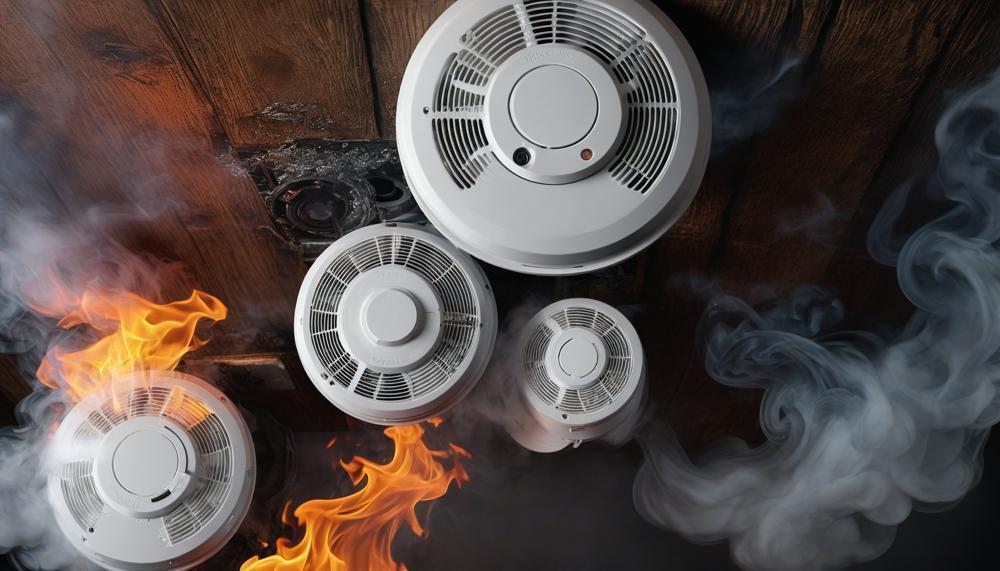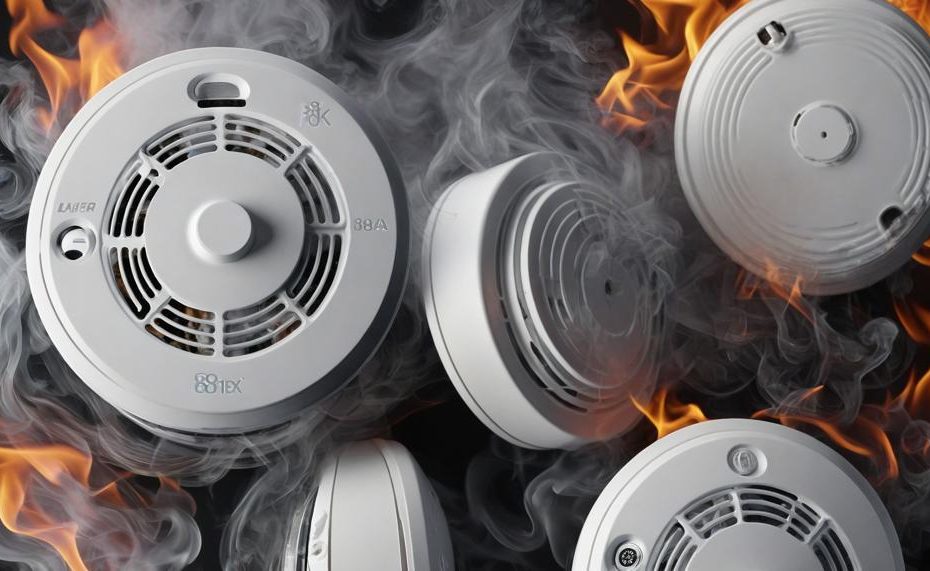Wondering how to dispose of old smoke detectors? It’s not as simple as tossing them in the trash. The proper method depends on the type of smoke detector you have. Photoelectric detectors can generally be discarded with your regular waste, provided you remove the batteries first.
However, ionization detectors require special handling due to the radioactive isotope they contain. Recycling these devices is crucial to prevent potential harm.
Key Takeaways:
- Identify the Type: Check the back of the detector for a “P” (photoelectric) or “I” (ionization).
- Photoelectric Detectors: Remove batteries and dispose of them in regular trash.
- Ionization Detectors: Do not dismantle; recycle them through specific programs.
- Recycling Options: Use the US Postal Service’s list of manufacturers that accept old detectors for recycling.
- Hazardous Waste Centers: Drop off at local hazardous waste collection sites if recycling isn’t an option.
- Replacement Schedule: Replace detectors every 10 years to ensure effectiveness.
Proper disposal of smoke detectors not only protects the environment but also ensures safety from potential exposure to harmful substances. Let’s dive into the details to make sure your old smoke detectors are handled correctly and responsibly.
Contents
Remove the Battery
The proper way to remove the battery from a smoke detector before disposing of it involves several straightforward steps:
- Locate the Battery Compartment: Most smoke detectors have a battery compartment on the back or side. Refer to the detector’s user manual if you’re unsure.
- Open the Battery Compartment: Use a screwdriver or press the latch to open the compartment. Be gentle to avoid damaging the unit.
- Remove the Battery: Carefully take out the battery. If it’s stuck, avoid using excessive force as this can damage the terminals.
- Check for Backup Battery: Some smoke detectors have a backup battery. Ensure you remove any additional batteries if present.
- Dispose of the Battery Properly: Batteries contain hazardous materials and should be recycled or disposed of at a designated battery disposal site.
We Recommend
We Recommend following these safe and proper methods for disposing of smoke detectors:
| Method | Description | Action |
| Manufacturer Instructions | Follow specific disposal instructions provided by the smoke detector’s manufacturer. | Check the user manual or manufacturer’s website. |
| Identify Alarm Type | Determine if the smoke detector can go into household waste or needs special recycling. | Consult local waste management services. |
| Battery Removal | Remove and separately dispose of batteries. | Use designated battery recycling points. |
| Take-Back Programs | Return smoke detectors to manufacturers participating in take-back programs. | Contact the manufacturer for details. |
| Local Ordinances | Follow any specific disposal regulations set by your local municipality. | Verify with local waste management or municipal offices. |
| Fire Department Guidance | Seek advice from your local fire department on proper disposal methods. | Contact your local fire department. |
Determine the Smoke Detector Type
Understanding the type of smoke detector in your home is crucial for effective fire safety. Here are the main types of smoke detectors and how to identify them:
| Type | Characteristics | Identification Tips |
| Ionization Smoke Detector | Uses a small amount of radioactive material to ionize air and create a current. Smoke particles disrupt this current, triggering the alarm. | Look for a label indicating the presence of radioactive material, often marked with a radiation symbol. Typically has a faster response to flaming fires. |
| Photoelectric Smoke Detector | Employs a light source and sensor. Smoke entering the chamber scatters the light, causing the alarm to sound. | Check for a label indicating a photoelectric sensor. More responsive to smoldering fires. |
| Dual Sensor Smoke Detector | Combines ionization and photoelectric technologies for broader detection capabilities. | Look for labels or specifications indicating both ionization and photoelectric sensors. Often labeled as “dual sensor.” |
| Heat Detector | Triggers an alarm when a certain temperature is reached or when there is a rapid rise in temperature. | Typically marked with heat sensitivity ratings. Does not respond to smoke. |
| Combination Detector (Smoke and Carbon Monoxide) | Detects both smoke and carbon monoxide, providing comprehensive safety coverage. | Check for a CO detection label or specifications mentioning both smoke and carbon monoxide sensors. |
To determine the type you have:
- Examine the Label: Most detectors have labels or markings indicating the type and technology used.
- Check the User Manual: The manual often details the type and features of the detector.
- Look for Visual Clues: Radiation symbols for ionization detectors, light chamber mentions for photoelectric, etc.
- Test the Detector: Dual sensor models may have more comprehensive testing procedures.
Toss It in the Trash
To safely dispose of your old smoke detector, follow these steps:
| Step | Action | Details |
| 1 | Check Local Guidelines | Contact local waste management for specific e-waste disposal rules. Learn more here. |
| 2 | Remove Batteries | Detach batteries and recycle them properly. Battery Recycling |
| 3 | Label the Detector | Mark the smoke detector as “DISPOSED” to prevent reuse. |
| 4 | Manufacturer Take-Back | Contact the manufacturer about take-back programs. Manufacturer Info |
| 5 | Install New Detector | Ensure fire safety by installing a new smoke detector. |
Send It Back to the Manufacturer
To safely return your smoke detector to the manufacturer for proper disposal, follow these steps:
| Step | Description | Additional Tips |
| Check Manufacturer’s Return Policy | Visit the manufacturer’s website or contact customer service for return instructions. | Look for free or affordable take-back programs. |
| Prepare the Smoke Detector | Remove batteries and label the detector as “DISPOSED”. | Follow local hazardous waste guidelines for battery disposal. |
| Packaging | Use the original packaging or a sturdy box with padding. | Ensure the detector is secure to prevent damage. |
| Shipping Instructions | Follow the manufacturer’s specific shipping instructions. | Double-check the address for the return center. |
| Post Office or Courier | Use a reliable shipping service with tracking. | Keep the receipt and tracking number for your records. |
Dispose of It as Hazardous Waste
Smoke detectors, particularly ionization types, may contain small amounts of radioactive material. Proper disposal is essential to prevent environmental contamination. Here’s a detailed guide:
Identify the Type
- Ionization Smoke Detectors: Contain a small amount of Americium-241.
- Photoelectric Smoke Detectors: Generally do not contain hazardous materials.
Consult Manufacturer Instructions
- Follow specific disposal instructions provided in the user manual or on the manufacturer’s website.
- Manufacturers often have take-back programs for used detectors.
Remove Batteries
- Before disposal, remove any batteries and dispose of them separately. Batteries can often be recycled at designated facilities.
Local Regulations
- Check with your local municipality for specific disposal ordinances. Some areas have special programs or designated drop-off locations for hazardous waste.
Return to Manufacturer
- Many manufacturers offer a return program. Package the detector securely and use a reliable shipping service to send it back for proper disposal.
Household Hazardous Waste Facilities
- If no manufacturer program is available, take the smoke detector to a household hazardous waste disposal facility. These facilities are equipped to handle items containing radioactive materials.
Do Not Incinerate
- Never incinerate smoke detectors as this can release harmful substances into the environment.

Conclusion
Proper disposal of smoke detectors is vital for safety and environmental protection. Smoke detectors come in two main types: photoelectric and ionization. Identifying the type is the first step—look for a “P” for photoelectric or an “I” for ionization on the back of the unit.
Photoelectric detectors can be discarded with regular trash once the batteries are removed. For ionization detectors, which contain a small amount of radioactive material, special handling is necessary. Do not dismantle these detectors; instead, recycle them through programs offered by manufacturers or local hazardous waste centers. The U.S. Postal Service provides a list of manufacturers that accept old detectors for recycling.
Here’s a quick guide:
- Remove Batteries: Safely remove and dispose of the batteries at designated recycling points.
- Identify the Detector Type: Look for labeling to determine if it’s photoelectric or ionization.
- Dispose of Photoelectric Detectors: These can go in regular trash after battery removal.
- Recycle Ionization Detectors: Use manufacturer take-back programs or hazardous waste centers.
Replacing smoke detectors every 10 years ensures optimal functionality and safety. By responsibly disposing of old detectors, we protect our environment and adhere to safety regulations.





